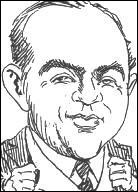Home > History > Famous PeopleFamous People of the Finger LakesHarold Eugene "Hal" Roach, Sr. (1892-1992)
It's not known how he met Mark Twain, a regular summer resident of Elmira at the time, but he is known to have delivered newspapers to Quarry Farm and he attended Park Church when Twain delivered a Sunday school speech there. The young Roach and Twain struck up a friendship and Roach was invited to spend time during weekends at Quarry Farm. It's difficult to know how this relationship affected the two, but certainly the humor of Twain carried over into Roach's career as a producer of comedies in Hollywood.
As for Roach affecting Twain, again this is hard to tell. But Roach was a real-life Tom Sawyer swimming in the Chemung River, which can be seen from Quarry Farm, and by Roach's own admission, he was kicked out of "most every school in Elmira." Certainly many of the antics of the Our Gang kids are similar to those of Tom Sawyer and his compatriots.
Like Twain who struck out for California, Roach headed west to Alaska where he too was a prospector among other things. He arrived in Hollywood in 1912 and worked as an extra in silent westerns. Using a $3,000 inheritance, he formed in 1914 his own production company, which later became known as The Hal Roach Studios, in Culver City outside of Hollywood. Here he produced short comedies with friend Harold Lloyd, who portrayed the character Lonesome Luke in some of these films.
The atmosphere of the Roach studios was said to be warm, lighthearted, and close-knit. Prior to World War II, Roach Studios hired Will Rogers, the Our Gang kids, ZaSu Pitts, Laurel and Hardy, Jean Harlow, Janet Gaynor, Fay Wray, and Boris Karloff to name just a few. Roach released his films first through Pathé, then through Metro-Goldwyn-Mayer, and finally through United Artists. In 1928 Roach converted his studios to sound and released his first talking short in 1929. In 1931 Roach Studios released its first full-length feature film, Pardon Us, staring Laurel and Hardy. This was followed by Topper (1937), Of Mice and Men (1939), and One Million B.C. (1940). As shorts became less profitable, they were phased out. The Our Gang series, for example, was sold to MGM in 1938.
Roach saw active duty in Normandy during World War II and reached the rank of lieutenant colonel. Dubbed "Fort Roach," his studios were leased to the Air Force whose Motion Picture Unit used them to make 400 military training, morale, and propaganda films with actors like Ronald Reagan and Alan Ladd.
Roach embraced new technologies, so it wasn't surprising that in 1947 Roach Studios was the first to produce all-color films. These four Cinecolor shorts cost more to produce than black-and-white and fell disappointingly short in revenue. Deeply in debt, Roach decided to switch exclusively to television production and, with his son Hal Roach, Jr., produced such shows as The Stu Erwin Show, The Gale Storm Show, and My Little Margie. Roach also made money leasing the facilities to independent producers whose television series included Amos 'n Andy, The Lone Ranger, Blondie, Groucho Marx, Abbott and Costello, The Life of Riley, and The George Raft Show. As more people bought televisions and more broadcast time was available, the popularity of television increased. By 1951 Roach Studios was producing 1,500 hours of television programming, nearly three times the output of feature films.
Despite the high output of television programs, Roach Studios continued to have financial problems. In 1955, Roach sold his share of the studios to his son, who lost them to creditors in 1962. With his studios no longer in his control, Roach retired, though he never totally left the business.
The Academy of Motion Picture Arts and Sciences, which presents the Academy Awards (also known as the Oscars) presented Roach with the following awards:
1931/32 (5th) SHORT SUBJECT (Comedy) The Music Box [certificate of honorable mention]1935 (8th) SHORT SUBJECT (Comedy) Tit for Tat [came in 3rd]1936 (9th) SHORT SUBJECT (One-reel) Bored of Education [plaque]1983 (56th) HONORARY AWARD To Hal Roach, in recognition of his unparalleled record of distinguished contributions to the motion picture art form. [statuette]
Roach never forgot his Elmira roots. Years after Mary Kornman and Mickey Daniels made the Little Rascals, they returned again in Boy Friends (the Little Rascals as teenagers), which featured in one short the cities of Elmira and Corning playing football. Nor did Elmira forget Roach. Elmira College awarded him with an honorary doctorate degree in 1988, the Hal Roach Scholarship is awarded to promising theatre students at Elmira College, a plaque honoring him can be found at the Clemens Center, and a pavilion bears his name at Grove Park.
Roach died in 1992 in Bel Air, California. He is buried along with Mark Twain and other famous Elmirans in Woodlawn Cemetery.
See also: http://www.filmreference.com/Writers-and-Production-Artists-Po-Ro/Roach-Hal.html http://www.encyclopedia.com/topic/Hal_Roach.aspx
Editor's Note: The above caricature is by Finger Lakes cartoonist Eugene "Zim" Zimmerman (1862-1936), of Horseheads, New York.
Updated 21 August 2011
|
|
|


 Anyone who's familiar with Laurel and Hardy and the kids from Our Gang knows the work of Hal Roach. Born in Elmira, Roach lived on Columbia Street until he was 16. He spent his free time as a teenager playing football for Elmira Free Academy (now Ernie Davis Middle School) and even saw magician Harry Houdini perform one of his escape routines while suspended over the Chemung River.
Anyone who's familiar with Laurel and Hardy and the kids from Our Gang knows the work of Hal Roach. Born in Elmira, Roach lived on Columbia Street until he was 16. He spent his free time as a teenager playing football for Elmira Free Academy (now Ernie Davis Middle School) and even saw magician Harry Houdini perform one of his escape routines while suspended over the Chemung River.